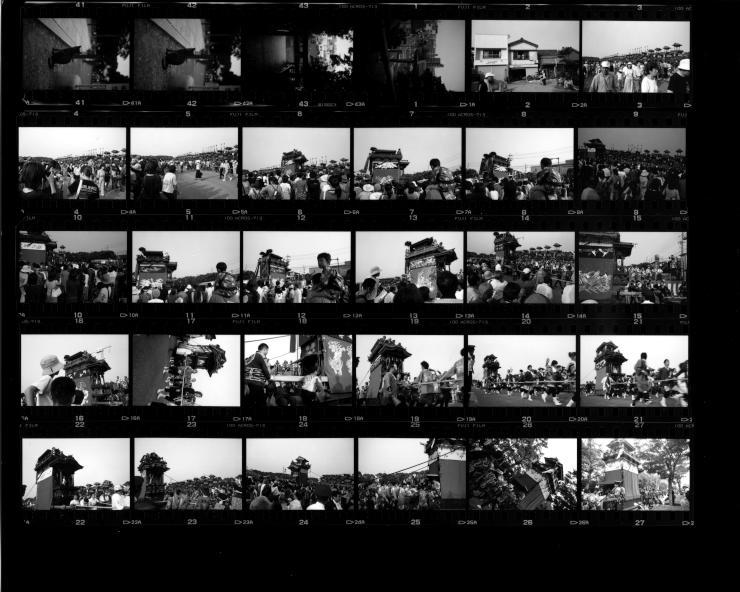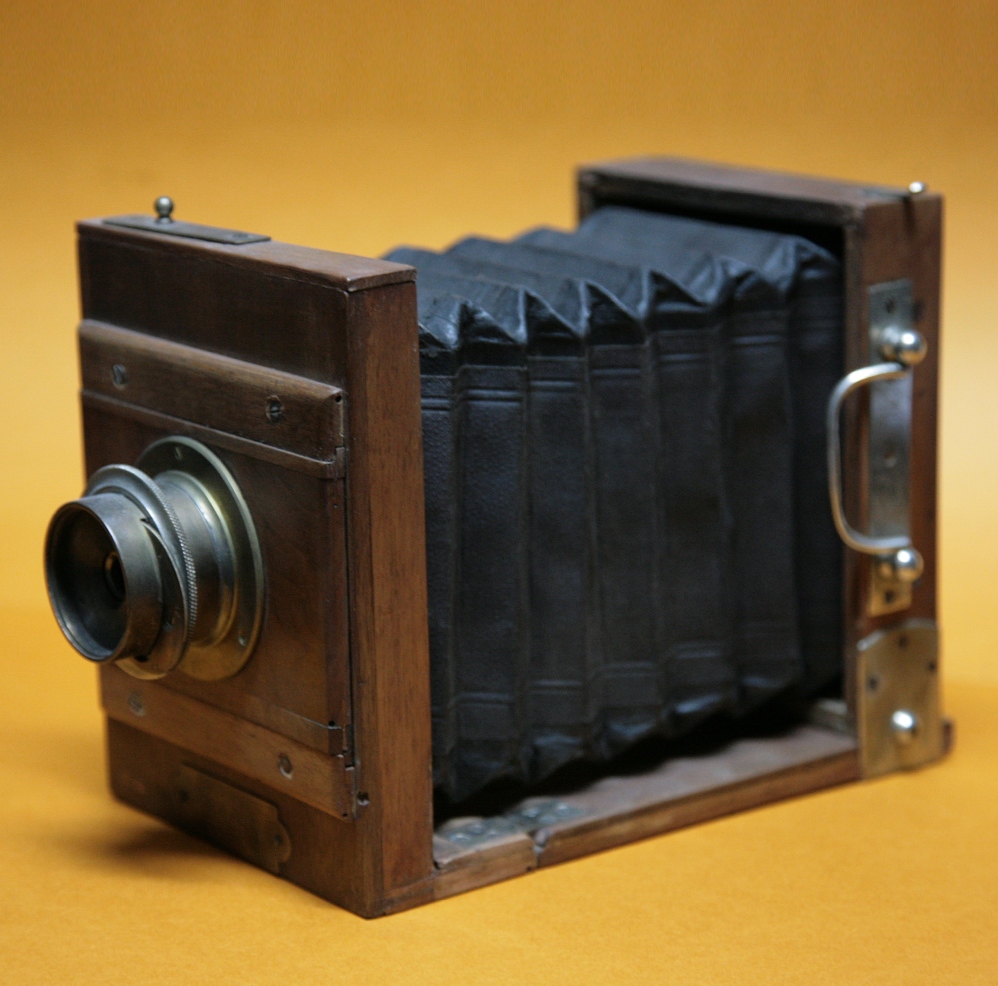|
Contact Print
A contact print is a photographic image produced from film; sometimes from a film negative, and sometimes from a film positive or paper negative. In a darkroom an exposed and developed piece of film or photographic paper is placed emulsion side down, in contact with a piece of photographic paper, light is briefly shone through the negative or paper and then the paper is developed to reveal the final print. The defining characteristic of a contact print is that the resulting print is the same size as the original, rather than having been projected through an enlarger. Basic tools Contact printing is a simple and inexpensive process. Its simplicity avails itself to those who may want to try darkroom processing without buying an enlarger. One or more negatives are placed on a sheet of photographic paper which is briefly exposed to a light source. The light may come from a low wattage frosted bulb hanging above an easel which holds them together, or contained in an exposur ... [...More Info...] [...Related Items...] OR: [Wikipedia] [Google] [Baidu] |
Thumbnail
Thumbnails are reduced-size versions of pictures or videos, used to help in recognizing and organizing them, serving the same role for images as a normal text index does for words. In the age of digital images, visual search engines and image-organizing programs normally use thumbnails, as do most modern operating systems or desktop environments, such as Microsoft Windows, macOS, KDE (Linux) and GNOME (Linux). On web pages, they also avoid the need to download larger files unnecessarily. Implementation Thumbnails are ideally implemented on web pages as separate, smaller copies of the original image, in part because one purpose of a thumbnail image on a web page is to reduce bandwidth and download time. Some web designers produce thumbnails with HTML or client-side scripting that makes the user's browser shrink the picture, rather than use a smaller copy of the image. This results in no saved bandwidth, and the visual quality of browser resizing is usually less than idea ... [...More Info...] [...Related Items...] OR: [Wikipedia] [Google] [Baidu] |
Paper Negative
The paper negative process consists of using a negative printed on paper (either photographically or digitally) to create the final print of a photograph, as opposed to using a modern negative on a film base of cellulose acetate. The plastic acetate negative (which is what modern films produce) enables the printing of a very sharp image intended to be as close a representation of the actual subject as is possible. By using a negative based on paper instead, there is the possibility of creating a more ethereal image, simply by using a type of paper with a very visible grain, or by drawing on the paper or distressing it in some way. One of the original forms of photography was based on the paper negative process. William Henry Fox Talbot's paper negative process, which was used to create his work " The Pencil of Nature", used a negative created on paper treated with silver salts, which was exposed in a camera obscura to create the negative and then contact printed on a similar p ... [...More Info...] [...Related Items...] OR: [Wikipedia] [Google] [Baidu] |
Projector
A projector or image projector is an optical device that projects an image (or moving images) onto a surface, commonly a projection screen. Most projectors create an image by shining a light through a small transparent lens, but some newer types of projectors can project the image directly, by using lasers. A virtual retinal display, or retinal projector, is a projector that projects an image directly on the retina instead of using an external projection screen. The most common type of projector used today is called a video projector. Video projectors are digital replacements for earlier types of projectors such as slide projectors and overhead projectors. These earlier types of projectors were mostly replaced with digital video projectors throughout the 1990s and early 2000s, but old analog projectors are still used at some places. The newest types of projectors are handheld projectors that use lasers or LEDs to project images. Movie theaters used a type of projector cal ... [...More Info...] [...Related Items...] OR: [Wikipedia] [Google] [Baidu] |
Analog Photography
Analog photography, also known as film photography, is a catch-all term for photography that uses chemical processes to capture an image, typically on paper, film or a hard plate. These analog processes were the only methods available to photographers for more than a century prior to the invention of digital photography, which uses electronic sensors to record images to digital media. In a film camera that uses photographic emulsions, light falling upon silver halides is recorded as a latent image, which is then subjected to photographic processing, making it visible and insensitive to light. Contrary to the belief that digital photography gave a death blow to film, film photography not only survived, but actually expanded across the globe. With the renewed interest in traditional photography, new organizations (like Film Is Not Dead, Lomography) were established and new lines of products helped to perpetuate film photography. In 2017, BH Photo & Video, an e-commerce site f ... [...More Info...] [...Related Items...] OR: [Wikipedia] [Google] [Baidu] |
Edward Weston
Edward Henry Weston (March 24, 1886 – January 1, 1958) was a 20th-century American photographer. He has been called "one of the most innovative and influential American photographers..." and "one of the masters of 20th century photography." Over the course of his 40-year career Weston photographed an increasingly expansive set of subjects, including landscapes, still-lifes, nudes, portraits, genre scenes and even whimsical parodies. It is said that he developed a "quintessentially American, and especially Californian, approach to modern photography" because of his focus on the people and places of the American West. In 1937 Weston was the first photographer to receive a Guggenheim Fellowship, and over the next two years he produced nearly 1,400 negatives using his 8 × 10 view camera. Some of his most famous photographs were taken of the trees and rocks at Point Lobos, California, near where he lived for many years. Weston was born in Chicago and moved to California when h ... [...More Info...] [...Related Items...] OR: [Wikipedia] [Google] [Baidu] |
Loupe
A loupe ( ) is a simple, small magnification device used to see small details more closely. They generally have higher magnification than a magnifying glass, and are designed to be held or worn close to the eye. A loupe does not have an attached handle, and its focusing lens(es) are contained in an opaque cylinder or cone. On some loupes this cylinder folds into an enclosing housing that protects the lenses when not in use. Optics Three basic types of loupes exist: * Simple lenses, generally used for low-magnification designs because of high optical aberration. * Compound lenses, generally used for higher magnifications to control optical aberration. * Prismatic, multiple lenses with prisms. Uses Loupes are used in many professions where magnification enables precision work to be done with greater efficiency and ease. Examples include surgery, dentistry, ophthalmology, the jewelry trade, gemology, and watchmaking. Loupes are also sometimes used in photography and printin ... [...More Info...] [...Related Items...] OR: [Wikipedia] [Google] [Baidu] |
Roll Film
Roll film or rollfilm is any type of spool-wound photographic film protected from white light exposure by a paper backing. The term originated in contrast to sheet film. Confusingly, roll film was originally often referred to as "cartridge" film because of its resemblance to a shotgun cartridge. The opaque backing paper allows roll film to be loaded in daylight. It is typically printed with frame number markings which can be viewed through a small red window at the rear of the camera. A spool of roll film is usually loaded on one side of the camera and pulled across to an identical take up spool on the other side of the shutter as exposures are made. When the roll is fully exposed, the take up spool is removed for processing and the empty spool on which the film was originally wound is moved to the other side, becoming the take up spool for the next roll of film. History In 1881 a farmer in Cambria, Wisconsin, Peter Houston, invented the first roll film camera. His younger bro ... [...More Info...] [...Related Items...] OR: [Wikipedia] [Google] [Baidu] |
Contact Sheet Photography
Analog photography, also known as film photography, is a catch-all term for photography that uses chemical processes to capture an image, typically on paper, film or a hard plate. These analog processes were the only methods available to photographers for more than a century prior to the invention of digital photography, which uses electronic sensors to record images to digital media. In a film camera that uses photographic emulsions, light falling upon silver halides is recorded as a latent image, which is then subjected to photographic processing, making it visible and insensitive to light. Contrary to the belief that digital photography gave a death blow to film, film photography not only survived, but actually expanded across the globe. With the renewed interest in traditional photography, new organizations (like Film Is Not Dead, Lomography) were established and new lines of products helped to perpetuate film photography. In 2017, BH Photo & Video, an e-commerce site f ... [...More Info...] [...Related Items...] OR: [Wikipedia] [Google] [Baidu] |
Namaka - Contact Sheet Art Photography
Namaka may refer to * Nāmaka, Hawaiian mythological sea goddess * Namaka (moon) Namaka is the smaller, inner moon of the trans-Neptunian dwarf planet Haumea. It is named after Nāmaka, the goddess of the sea in Hawaiian mythology and one of the daughters of Haumea. Discovery Namaka was discovered on 30 June 2005 and ..., inner moon of the dwarf planet Haumea * Namaka, Alberta, hamlet in southern Alberta, Canada * Namaka, Fiji, a place in Fiji next to Nadi, home of Pacific Island Air {{disamb, geo ... [...More Info...] [...Related Items...] OR: [Wikipedia] [Google] [Baidu] |
Motion Picture
A film also called a movie, motion picture, moving picture, picture, photoplay or (slang) flick is a work of visual art that simulates experiences and otherwise communicates ideas, stories, perceptions, feelings, beauty, or atmosphere through the use of moving images. These images are generally accompanied by sound and, more rarely, other sensory stimulations. The word "cinema", short for cinematography, is often used to refer to filmmaking and the film industry, and to the art form that is the result of it. Recording and transmission of film The moving images of a film are created by photographing actual scenes with a motion-picture camera, by photographing drawings or miniature models using traditional animation techniques, by means of CGI and computer animation, or by a combination of some or all of these techniques, and other visual effects. Before the introduction of digital production, series of still images were recorded on a strip of chemically sens ... [...More Info...] [...Related Items...] OR: [Wikipedia] [Google] [Baidu] |

.jpg)





